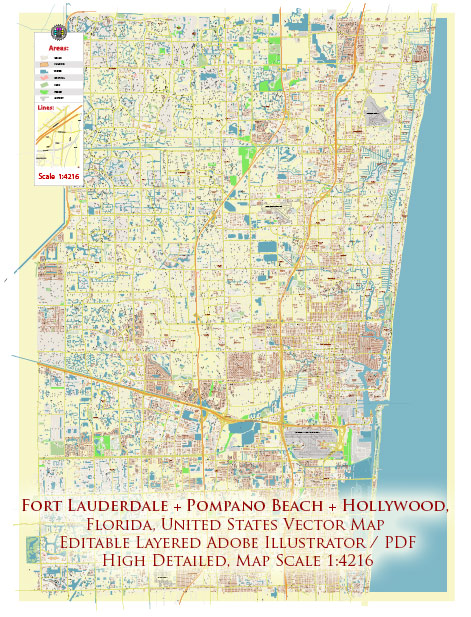The history of urban development in Fort Lauderdale, Pompano Beach, and Hollywood, Florida, is characterized by a combination of factors such as geographic location, economic activities, and population growth. Each city has its unique story, but they share common themes of growth, urbanization, and the influence of industries like tourism and real estate.
Fort Lauderdale:
- Early Years (pre-20th century): Fort Lauderdale’s history dates back to the Second Seminole War in the 1830s when a fort was built. The area remained sparsely populated until the arrival of the Florida East Coast Railway in the early 20th century, connecting Fort Lauderdale to Miami and facilitating transportation.
- Boom in the 1920s: Fort Lauderdale experienced significant growth during the Florida land boom of the 1920s. The city’s population surged, and the economy expanded with real estate development and tourism.
- Military Presence during World War II: The city played a role in World War II with the establishment of Naval Air Station Fort Lauderdale. After the war, the region continued to grow, driven in part by returning veterans.
- Tourism and Real Estate Development: Fort Lauderdale’s transformation into a popular tourist destination and a hub for real estate development occurred in the mid-20th century. The city’s waterways, beaches, and tropical climate became major attractions.
- Modern Development: Today, Fort Lauderdale is known for its boating canals, upscale neighborhoods, and a thriving tourism industry. The city has seen ongoing urban development, including the revitalization of downtown areas and the construction of high-rise buildings.
Pompano Beach:
- Early Settlement: Pompano Beach started as a farming community in the late 19th century, primarily focused on tomato farming. The extension of the Florida East Coast Railway in the early 20th century contributed to the town’s growth.
- Post-WWII Growth: After World War II, Pompano Beach experienced significant population growth, partly due to the returning veterans and the general economic boom of the post-war period.
- Tourism and Development: Like Fort Lauderdale, Pompano Beach benefited from Florida’s reputation as a tourist destination. The city developed as a vacation spot with the expansion of hotels and recreational facilities.
- Economic Diversification: Over the years, Pompano Beach has sought to diversify its economy beyond tourism, encouraging commercial and industrial development.
Hollywood:
- Early Development: Hollywood, Florida, was founded in the 1920s and was designed to be a “Dream City” with a Mediterranean Revival style. It quickly became a popular winter resort.
- Post-World War II Era: Hollywood experienced a population boom in the post-World War II era, fueled by returning veterans and a growing interest in Florida as a retirement destination.
- Tourism and the Entertainment Industry: Hollywood’s name has often been associated with the entertainment industry, and it has attracted celebrities and filmmakers. The city’s beachfront and boardwalk contribute to its appeal as a tourist destination.
- Urban Renewal and Redevelopment: In recent decades, Hollywood has undergone urban renewal efforts, focusing on the redevelopment of the downtown area and the enhancement of the city’s infrastructure.
These cities, with their distinct histories and trajectories, showcase the broader trends in Florida’s urban development, shaped by factors like transportation, tourism, and economic diversification.


 Author: Kirill Shrayber, Ph.D.
Author: Kirill Shrayber, Ph.D.